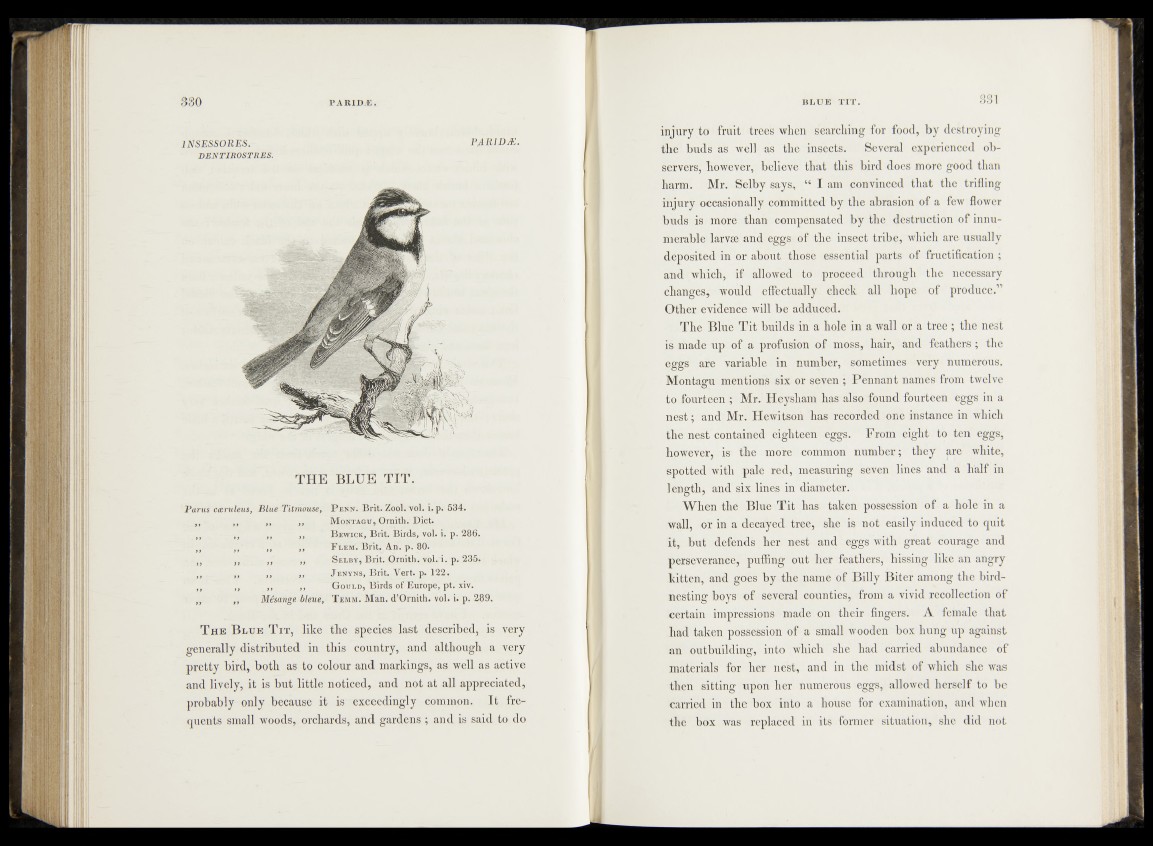
8 3 0 PP AA RR 1IDDÆÆ ..
1NSESSORES.
DENTIROSTRES.
PARIDÆ.
mm
/ 1 Jlf » f
WEÊÊIgï
TH E BLUE T IT .
Parus cæruleus, Plue Titmouse, P enn. Brit. Zool. vol. i. p. 534.
M ontagu, Ornith. Diet.
B ewick, Brit. Birds, vol. i. p. 286.
F lem. Brit. An. p. 80.
S elby, Brit. Ornith. vol. i. p. 235.
J enyns, Brit. Vert. p. 122.
Gould, Birds of Europe, pt. xiv.
J; () Mésange bleue, ï e m m . Man. d’Ornith. vol. i. p. 289.
T he B lue T it, like the species last described, is very
generally distributed in this country, and although a very
pretty bird, both as to colour and markings, as well as active
and lively, it is but little noticed, and not at all appreciated,
probably only because it is exceedingly common. It frequents
small woods, orchards, and gardens ; and is said to do
_ Q Q 1 B L U E T IT . OO I
injury to fruit trees when searching for food, by destroying
the buds as well as the insects. Several experienced observers,
however, believe that this bird does more good than
harm. Mr. Selby says, “ I am convinced that the trifling
injury occasionally committed by the abrasion of a few flower
buds is more than compensated by the destruction of innumerable
larvae and eggs of the insect tribe, which are usually
deposited in or about those essential parts of fructification ;
and which, if allowed to proceed through the necessary
changes, would effectually check all hope of produce.”
Other evidence will be adduced.
The Blue Tit builds in a hole in a wall or a tree ; the nest
is made up of a profusion of moss, hair, and feathers ; the
eggs are variable in number, sometimes very numerous.
Montagu mentions six or seven ; Pennant names from twelve
to fourteen ; Mr. Heysham has also found fourteen eggs in a
nest; and Mr. Hewitson has recorded one instance in which
the nest contained eighteen eggs. From eight to ten eggs,
however, is the more common number; they are white,
spotted with pale red, measuring seven lines and a half in
length, and six lines in diameter.
When the Blue Tit has taken possession of a hole in a
wall, or in a decayed tree, she is not easily induced to quit
it, but defends her nest and eggs with great courage and
perseverance, puffing out her feathers, hissing like an angry
kitten, and goes by the name of Billy Biter among the birdnesting
boys of several counties, from a vivid recollection of
certain impressions made on their fingers. A female that
had taken possession of a small wooden box hung up against
an outbuilding, into which she had carried abundance of
materials for her nest, and in the midst of which she was
then sitting upon her numerous eggs, allowed herself to be
carried in the box into a house for examination, and when
the box was replaced in its former situation, she did not